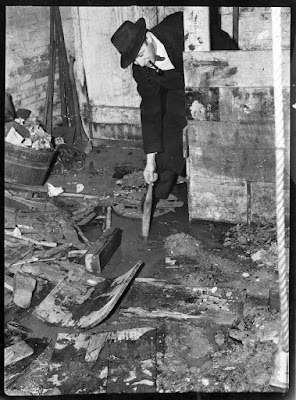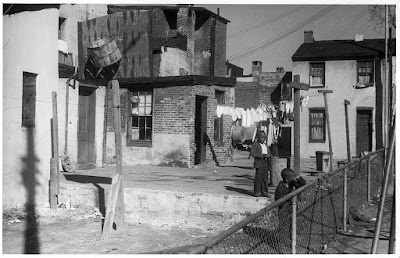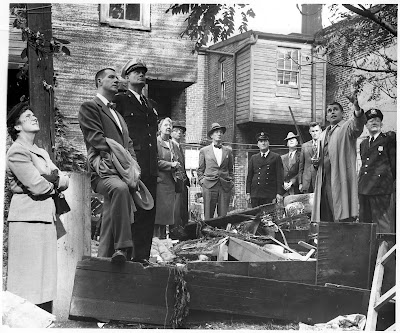 |
| Inspection by Health Department, courtesy of the CPHA Collection, via flickr |
Next week, Langsdale Special Collections is hosting a colloquium where three fellows are going to give presentations on their research into structural inequality, sharing the information they unearthed in Special Collections over the summer. I say this not only to mention that it’s happening (September 28th at 4 p.m., Learning Commons Town Hall– see you there!), but because whenever we’re promoting the fellowship, I have go-to collections I use to illustrate the concept, and The Citizens Planning and Housing Association (CPHA) records is one of the best to draw upon. Most of the digitized photos in the CPHA flickr album perfectly portray urban blight and how society has failed its most vulnerable citizens– scenes of trash-strewn alleys, decaying structures, toppling fences, lean-to shacks, and children playing in the rubble circa the 1940s and ‘50s. Contextually, many of these photos were taken during inspections by the Health Department, who were surveying the area’s cleanliness and overall habitability for its citizenry.
 |
| Basketball Hoop, CPHA Collection, via flickr |
These shots of the CPHA’s Broadway “slum tours” did not escape the notice of the director of Rat Film, native Annapolitan Theo Anthony. Photographs from the CPHA collection are used extensively in this unusual documentary about Baltimore’s war on pestilence– specifically, rats– and the confluence of conditions that exist to help both vermin and abject poverty thrive here. The strange thing about these old, 60- and 70-year-old photos is that many of Baltimore’s back alleys look pretty much the same; the CPHA photos are some of the least dated-looking old photographs I’ve seen in an historical collection. Rat Film shows citizens grappling with our modern-day rat problems in inventive ways– befriending rats, fishing for rats, philosophizing about rats…but, chillingly, not successfully eradicating them.
 |
| Tour Group, Broadway Slum Renewal, CPHA Collection, via flickr |
A researcher from Rat Film’s production team visited Special Collections between December 2015 and May 2016 to not only find images to work with, but to round out some of the historical context for Rat Film’s central thrust– that the key to rat-free living is to address poverty and under-served populations. Rat Film also sheds light on Baltimore’s history as it relates to urban planning and renewal. Rat Film isn’t really as dry a treatise as I’ve described it here– Langsdale’s Head of Special Collections Aiden Faust reports that Rat Film is not for the squeamish, but also is not a straightforward expository narrative. He describes it as being more along the lines of one of Werner Herzog’s peculiar nonfiction explorations. You can catch Rat Film this week at the Parkway Theater in the Station North Arts District. If you’d like to explore the CPHA collection first hand– which in addition to photographs, contains letters, organizational records, digitized content, and artifacts, click here to make an appointment.